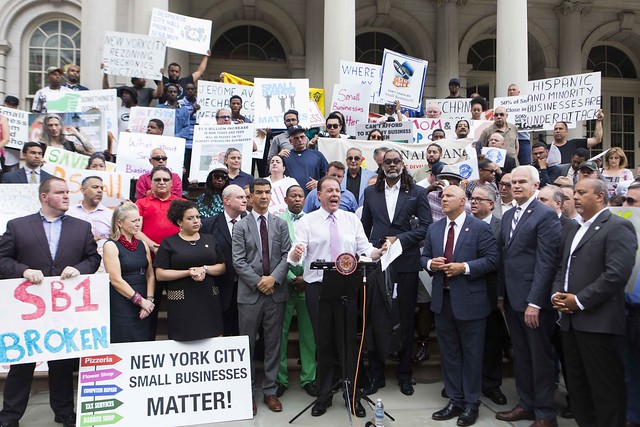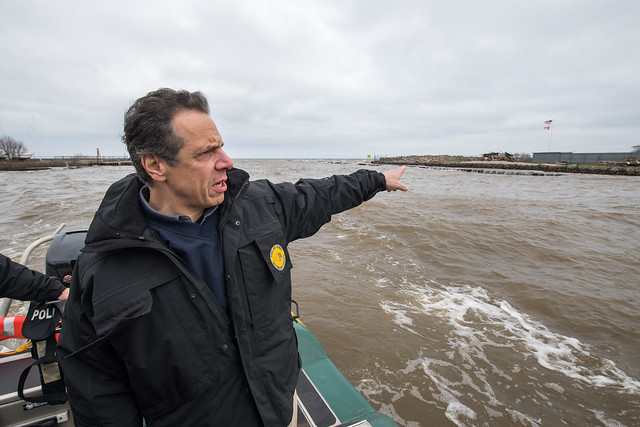Policymakers Can’t Have It Both Ways If They Want to Save Jobs

(photo: Emil Cohen/City Council)
The number of jobs in New York City reached an all-time high this year, bringing the unemployment rate to record lows. We are the envy of the nation. But there is one key sector where jobs are declining. For the first time in more than a decade, we are seeing job losses among restaurants and food service establishments.
In an attempt to halt some of these losses, City Council Members Brad Lander and Adrienne Adams introduced legislation to prohibit employers from firing fast food workers without just cause, meaning for any reason other than misconduct or failure to perform job duties. They cite surveys showing that many fast food workers who have been terminated or had their hours cut were given no explanation as to why.
While well-intentioned, this proposal misses the mark because it ignores the underlying causes.
It’s as if lawmakers are trying to have it both ways by, first, imposing costly new requirements on businesses and, then, preventing them from making the difficult but legitimate staffing changes necessary to comply.
Small business owners certainly do not want to eliminate jobs. There is no joy derived from laying off employees. But the reality is that local regulations have so fundamentally altered the way that businesses operate here that employers often have no choice but to eliminate some positions in order to stay afloat.
Consider just a few of the mandates recently imposed on local businesses.
New York’s minimum wage has increased every year since 2013, reaching $15 an hour for most businesses in the city this year. This has been difficult for some to absorb because government has implemented other costly mandates at the same time.
In May 2013, the New York City Council passed legislation requiring employers with 20 or more workers to provide at least five days of paid sick leave. The following year the law was expanded to capture small businesses with as few as five employees.
In 2016, New York State’s Paid Family Leave Act was adopted, requiring businesses of all sizes to accommodate up to 10 weeks of paid leave for employees to care for a new child, care for family members that are ill, or assist loved ones when a family member is deployed abroad on active military duty.
These are all incredibly important initiatives, but the truth is that someone has to pay for them.
When the Manhattan Chamber of Commerce surveyed our members last year, small businesses cited the high cost of doing business in New York as the thing most negatively affecting them. Yet instead of helping small businesses compete more effectively, policymakers have signaled that more costly mandates are on the way.
Mayor de Blasio wants to force businesses with five or more employees to provide each with two weeks of paid vacation. Most medium and large companies already offer generous paid time off benefits, so it is primarily small businesses that will bear the brunt.
Similarly, lawmakers in Albany are considering eliminating the tip credit, which would dramatically increase payroll costs at restaurants and certainly trigger more job losses.
Is it any wonder that small businesses don’t feel that local government has their back?
If compliance with the law imposes perpetually-increasing costs of operation, businesses simply cannot raise prices at a rate that consumers will accept. Consequently, business owners are forced to cut costs wherever possible, including jobs. Preventing businesses from making those decisions will not save jobs; it will simply spell the end for many businesses.
The bottom-line: If lawmakers truly want to protect jobs, they must give regulatory relief to the businesses that provide those jobs and stop pretending that they can have it both ways.
***
Jessica Walker is President of the Manhattan Chamber of Commerce. On Twitter @jessinharlem & @ManhattanCofC.
***
Have an op-ed idea or submission for Gotham Gazette? Email This email address is being protected from spambots. You need JavaScript enabled to view it.
Governor Cuomo Has Just Weeks to Embrace a Real Green New Deal for New York

Gov. Cuomo (photo: governor's office)
As debate over the Green New Deal has seized the nation, the young people of Sunrise Movement have been challenging politicians to answer a simple question: What is your plan?
In April, the New York City Council rose to that challenge with a series of bills that sets a high-water mark for urban climate action across the globe. Mayor de Blasio is expected to sign the Climate Mobilization Act soon.
Governor Cuomo, meanwhile, has allowed the Climate and Community Protection Act (CCPA), the most ambitious climate legislation in the country, to languish in Albany. “I don’t see anything specific for the rest of the session” in terms of environmental legislation, the governor said recently -- a shocking statement considering the lack of climate action coming from Albany -- about the state government agenda before the legislative session ends mid-June.
Climate change is an existential threat for my generation. Young people deserve more than lip service from leaders who have consistently failed to confront the crisis over the past decade.
New Yorkers know this. We’ve seen the impacts of climate change and fossil fuel pollution in record-breaking heat waves, devastating hurricanes like Superstorm Sandy, and overwhelmingly high rates of asthma and other respiratory diseases. We know we need to act urgently to meet the scale of the challenge.
To his credit, Governor Cuomo put forth a vision for climate action in his executive budget. He calls it a Green New Deal. Unfortunately, his plan is not worthy of the name.
The young people of Sunrise ask politicians to share their plans so that we can see who is serious about tackling climate change and who is not. We have three criteria for judging what constitutes a serious plan to address the crisis.
First, the Green New Deal needs to transition the entire economy to clean energy. Governor Cuomo only sets enforceable decarbonization targets for the electricity sector.
Second, the Green New Deal needs to make sure resources flow directly to the communities hit hardest by climate change – particularly communities of color and low-income neighborhoods. The governor talks about environmental justice – but his plan fails to put his money where his mouth is.
Finally, the Green New Deal needs to center the good, family-supporting jobs that will be created through investments in renewable energy. The governor’s proposal doesn’t yet outline a comprehensive way to make that happen.
Here’s the thing: the Climate and Community Protect Act, which predates Governor Cuomo’s ‘Green New Deal,’ would accomplish these three needs. The CCPA is a vision for climate justice that has been improved and expanded and revised for almost four years with the support of over 150 community, labor, and environmental organizations.
Spearheaded by a coalition called NY Renews, the CCPA is the holistic approach to the climate crisis that New Yorkers deserve. The coalition’s plan sets a legally enforceable timeline to get New York’s entire economy off of fossil fuels by 2050 while also ensuring that 40 percent of state funding goes to frontline and vulnerable communities (low-income and communities of color, among others, facing the brunt of environmental harms), and that the green jobs created are also good jobs that follow prevailing wages and provide training and apprenticeships when possible.
The federal Green New Deal resolution introduced by Rep. Alexandria Ocasio-Cortez has broken new ground for its success in bringing climate change to the fore in Congress. But in New York, the CCPA has for years been a model for climate legislation that centers both good jobs and healthy communities.
Climate change, pollution, and environmental harms have exacerbated systematic inequality by disproportionately affecting indigenous communities, communities of color, migrant communities, deindustrialized communities, depopulated rural communities, the poor, low-income workers, women, the elderly, the unhoused, people with disabilities, and yes, youth like young climate strikers and the Sunrise members that have been showing up nationwide to push their representatives toward climate action.
Governor Cuomo says he wants to be at the forefront of the climate movement — framing his proposals as a ‘Green New Deal’ demonstrates as much. But the way New York should lead the climate movement is by modeling the power of community-focused action. The governor’s plan wouldn’t get us to 100 percent renewable energy economy-wide, and it doesn’t include the kinds of provisions we need for jobs or justice. Superstorm Sandy has already showed us how necessary it is to invest in the frontline communities hit hardest by the climate crisis. No justice, no deal.
The CCPA, however, enshrines in law an enforceable timeline to eliminate fossil fuels throughout New York by 2050, meaning that New Yorkers will not only have a plan, they will have recourse to ensure the state follows through.
The CCPA has passed the State Assembly three times already, only to be stopped by what used to be the climate change-denying, Republican Senate leadership. That’s changed now, and Democratic Senate Majority Leader Andrea Stewart-Cousins has embraced the CCPA and its coalition of community, labor, and environmental groups.
If Governor Cuomo can’t commit to supporting the CCPA, then the state legislature needs to force his hand by putting the bill on his desk.
In 2019, all climate action is long past due. With the federal Green New Deal stalled in Congress thanks to fossil fuel executives and their allies in Republican leadership, what we need now is for our state leaders to step up. The CCPA is ready, and New Yorkers are ready too.
The question is, is the governor?
***
Matthew Miles Goodrich is New York State Director of Sunrise Movement. On Twitter @mmilesgoodrich & @sunrisemvmt.
***
Have an op-ed idea or submission for Gotham Gazette? Email This email address is being protected from spambots. You need JavaScript enabled to view it.
Manhattan GOP Goes Full Trump, Ruining Chances for Years to Come

(photo: @RealDonaldTrump)
Well, it’s happened. The barbarians have finally sacked the city.
On February 1, Trump enthusiast Ian Walsh Reilly assumed the leadership of the Metropolitan Republican Club, one of the oldest Republican clubs in New York City. Like Trump, Ian’s the kind of guy who bumps elbows with high-profile racists and unrepentant misogynists like Gavin McInnes, founder of the alt-right nationalist group The Proud Boys.
Ian just couldn’t wait to get Gavin in front of his club’s membership last year, and this epic lapse in judgment resulted in a nearly 24-hour cycle of violence and vandalism – on Manhattan’s tony Upper East Side no less.
Then, on April 20, Ian’s lickspittle lackey Gavin Wax and sidekick Vish Burra claimed top spots at the New York Young Republican Club. (Wax is currently facing criminal charges of Forcible Touching and Sexual Abuse, while Burra was charged with felony drug possession in 2015.)
These organizations form the backbone of the Manhattan GOP’s voter and volunteer base, and are now firmly under the control of Trumpist alt-right acolytes, which puts Manhattan Republican Party Chair Andrea Catsimatidis in a bit of a bind.
Trump lost Manhattan in the 2016 GOP Primary to John Kasich, and scored less than 10% of the vote borough-wide on Election Day. For a party organization tasked with recruiting candidates, raising money, and winning elections, I’m stumped as to what their endgame strategy is.
No serious New York City candidate will ever run on a Republican ticket with Trump, and no candidate who embraces Trump will ever win in the city (outside of Staten Island – and sometimes not even there).
Could the ascent of people like Wax, Burra, and Reilly be a sign that local County Committees and their ancillary groups have simply thrown in the towel on ever building a real party apparatus, and have instead opted to simply cash in on the rubes and dupes and Pizzagate pushers that comprise the monochromatic Trump coalition?
Sure seems like it.
If Trump wins re-election in 2020, his personality and policies will undoubtedly reshape the current Republican Party for many years to come. But if Trump is defeated, then the GOP, especially in urban areas, will have a unique opportunity to redefine what it means to be a Republican in the 21st Century.
However, those who embraced Trump, either half-heartedly or with bear hugs, won’t be able to make that case. Sorry, but Trump taint just don’t bleach.
New York City constitutes nearly half the statewide vote, and from day one, it’s been abundantly clear that Trump does not share the city’s values.
But until Manhattan and other borough Republicans disavow, disassociate, and condemn the president, a majority of city voters simply won’t give two cowpats about what ideas we have on public housing, higher education, infrastructure, jobs, student debt, and criminal justice reform.
If our leaders refuse to assert themselves at the grassroots level – or worse yet, co-opt the alt-right message, then the GOP in the Empire State is doomed.
We need our County Chairs and State Party officers to lead, to communicate to young people and veteran activists alike what a winning strategy and message look and sound like. Hint: it’s not Donald J. Trump.
But if they’re either unwilling or unable to do so, then perhaps the time has come for experienced operatives and establishment groups, who have so far largely stood on the sidelines and quietly seethed, to strike back with a vengeance in order to preserve the party of Teddy Roosevelt so that it won’t be spoken of in the same breath as ‘pussy’-grabbers, conspiracy theorists, and xenophobes.
***
John William Schiffbauer is a political consultant, and was the Deputy Communications Director for the New York Republican State Committee from 2014 to 2016. On Twitter @JWSGOP.
***
Have an op-ed idea or submission for Gotham Gazette? Email This email address is being protected from spambots. You need JavaScript enabled to view it.




